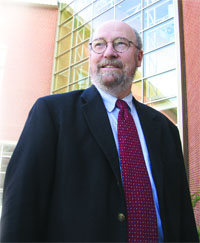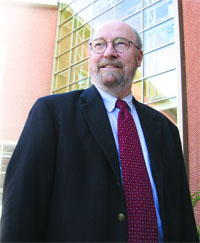
It’s All State of the Art
New Facility at UMass Should Prove to Be a Big Draw
UMass Amherst recently opened the doors to a new, $26 million Studio Arts Building. The facility brings together a number of two- and three-dimensional art programs that had been scattered across the vast campus often in facilities that were cramped and not up to modern building codes and creates, with the nearby Fine Arts Center, what one administrator calls an integrated arts district on campus. But the center will also benefit the region as a whole, say school administrators, by making the universitys arts programs more attractive, thus bolstering the Western Mass. creative community.
Joel Martin has a number of descriptive nouns and adjectives he applies liberally to the new Studio Arts Building at UMass Amherst.
Martin, dean of the College of Humanities & Fine Arts, calls it a well, a source, a talent magnet, and even a talent factory. He deployed those terms and others to explain how the $26 million facility, which opened this past month and brings a host of two- and three-dimensional arts programs that were spread across the campus together under one roof and tons of glass, will help bring more talented art students to the school and thus bolster the regions creative community.
He believes this because he has data showing that many of the artists living and working in this area said in a recent survey that they probably wouldnt be doing business in this market if they hadnt been exposed to it while attending college here. And the new Studio Arts Building, which has heen roughly 30 years in the making, according to some long-time administrators in the College of Arts & Humanities, will be a very effective recruiting tool.
Everything in it is state-of-the-art, said Martin, acknowledging while also embracing the play on words, as he referred to everything from the air handlers to table saws in the woodworking area in the 47,000-square-foot building. Its a wonderful learning facility its makes great use of light, and there are some grand spaces; we really needed to have a state-of-the-art, safe, environmentally sound facility so that our artists energies could be best used. And now we have one.
Ron Michaud, associate dean of the College of Humanities & Fine Arts, and former chair of the arts program, has been advocating for something like the Studio Arts Building for years now. He said the universitys arts programs have functioned well over the past half-century, and have succeeded in helping a number of accomplished artists painters Chuck Close and Shan Shan Sheng, among them develop their talents and find their potential.
But it can do much more of the same with the gleaming new facility, which, when coupled with the nearby Fine Arts Center, creates what Michaud called an integrated arts district on the campus.
Like Martin, Michaud said the new arts center makes UMass a stronger player as it competes with such institutions as the R.I. School of Design, the Pratt Art Institute, and a host of public colleges and universities for top art students. And the hope and expectation is that some of this talent will remain in the Pioneer Valley.
A building like this can really become a magnet for talented people across this region and also well beyond, said Michaud. This will put this university on a higher level, and also help this region and its economy.
The Proper Framework The art barn.
Thats the nickname, if one could call it that, attached to one of the now former homes for studio arts programs at the university. The barn, located in the northwest corner of the campus not far from the Mullins Center, hosted painting classes for decades, said Michaud, and is now a facility housing lawnmower-repair operations or something like that.
Another former art program facility, one recently razed to make way for an integrated sciences building, was a post-World War II army barracks annexed by the college. It housed sculpture programs and some instructional space, Michaud noted, adding that, overall, programs have been spread across as many as 19 buildings, most of them cast aside by other departments that didnt want or need them anywhere.
Some of these facilities, like the art barn, were considered warm and cozy, and actually had some fans, he continued, but they were not designed to house creative arts programs, were inefficient, and were often several hundred yards away from buildings hosting other programs.
Even the universitys Fine Arts Center, opened in the early 70s and designed mostly for the performing arts, lacked what would be considered modern, efficient space for most of the studio arts programs offered by the school, said Michaud, noting that, in many respects, the sprawling complex has been showing its age with respect to considerations such as ventilation, waste disposal, green design, an even instructional facilities.
A succession of students and, more importantly, administrators within the vast College of Humanities & Fine Arts, recognized the problem and the need to do something about it, he continued, but it wouldnt be until the start of this decade before mobilized efforts succeeding in generating some action.
In 1995, we conducted a comprehensive study of our inventory of facilities, said Michaud, and came away knowing that we needed a new studio-arts building to remain competitive nationally and internationally.
People came together behind a common vision, and eventually convinced the administration that we needed something like this, he continued as he began a tour of the new facility, one that encountered several classes in progress and artists at work.
As he started down one wing of the V-shaped complex, it didnt take Michaud long to make his point about bringing once-scattered programs together in one space. Indeed, the woodworking, welding, sculpture, and ceramics programs were all arranged in a row. Before, these were spread across campus, he explained, noting that most former settings simply werent designed to house kilns or welding equipment.
On its ground floor, the center features a high-end digital and computer-graphics studio, a central location for photography, and facilities for instruction in such disciplines as lithography, etching, and silk-screening.
The instructional areas are much larger, in most cases, than what we had before, and theyre more efficient, he explained, giving students the facilities they need to learn.
Martin agreed, and noted that for decades, the College of Arts & Humanities had been adjusting or trying to adjust whatever space came its way to accommodate whatever program, be it woodworking or pottery, that needed room. Now, it has space custom-designed for each discipline.
The center is also one of the greenest on the UMass campus, said Michaud, noting that it makes use of sustainable building materials, operable windows for natural ventilation, and a variety of energy and water-conservation measures.
Breaking the Mold
As he stopped in the large, open common area that serves as the primary entrance point as well as a gathering space for students and faculty and venue for art shows and guest lectures, Michaud remarked at how quiet it was at that time (late afternoon).
You wont see it like this very often, he said, adding that he and others expect that space, complete with high windows and expansive views of the campus, to help generate a stronger sense of community among artists who had been working in the four corners of the sprawling campus.
And that notion of community is important, said both administrators, because those in the arts thrive in settings where they can share ideas and critique each others work.
We now have facilities where people can meet, have lunch, talk about what theyre working on, and compare work, Martin explained. And thats really important as they develop individual arts, but also as they compare and blend different forms of art, and perhaps even create new forms of art.
But while creating a larger, stronger, and more-visible arts community on campus where all this can happen, the new Studio Arts Building is also expected to have a broad impact beyond the universitys borders, said Martin and Michaud.
Noting that many communities across the Pioneer Valley are looking to the arts and the so-called creative economy to help fill old mill buildings left quiet by the exodus of paper and textiles makers and other manufacturers and breathe new life into downtowns that can longer prosper through retail, Martin said the new facility can help provide the key ingredient to all those aspirations artisans.
The creative economy, no matter how you define it, ultimately rests on having creative people with talent generating fresh ideas, approaches, and designs, to help create art, but also to communicate, persuade, and market this art, he explained.
And this is where Martin summoned those descriptive terms to drive home his points concerning what the Studio Arts Building is and will ultimately become as the region and individual communities focus on the arts as an instrument of economic development.
Were the talent magnet that attracts the greatest number of talented people in the Valley, he explained. And with this facility, we can now attract and retain the most talented student artists in the country and the most talented faculty and artists. We have a state-of-the-art facility that is a pump, a source, a well that will feed this Valley.
Citing a survey of College of Humanities & Fine Arts alumni, released just a few months ago, Martin that a large percentage (nearly half) of those queried said they likely would not be working in the Valley as writers, photographers, painters, and sculptors if they had not attended the university and thus become exposed to the regions amenities and quality of life.
When you look at those numbers, its clear that if we can bring more top talent to this university, we can, potentially, keep more of it in this region, he explained. Thats why people pushed so hard for so many years to get a facility like this.
Brush with Success
As he passed two students conversing in the undergraduate studio area on the second floor of the new facility, Michaud offered a question, and an opinion, with the words, better than the art barn, isnt it?
There was a moments hesitation while the students thought this over a reflection of how some liked the old accommodations, despite their limitations but eventually some nods of approval.
There will be more of those as the buildings facilities, amenities, and displayed works of art including a piece by Shan Shan Sheng due to be installed later this month come to be known and fully understood.
Thats to be expected with a building that is truly state-of-the-art, in every sense of that phrase.
George OBrien can be reached at[email protected]





